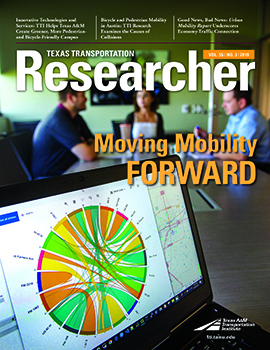Spanning more than 5,200 acres, Texas A&M University’s College Station campus is one of the largest public institutions of higher learning in the world. The recently completed 2017 Campus Master Plan provides the framework for future development of the campus with one of its focus elements being mobility and safety. The Texas A&M Transportation Institute (TTI) is exploring ways to make the flagship campus more walkable and bicycle friendly.
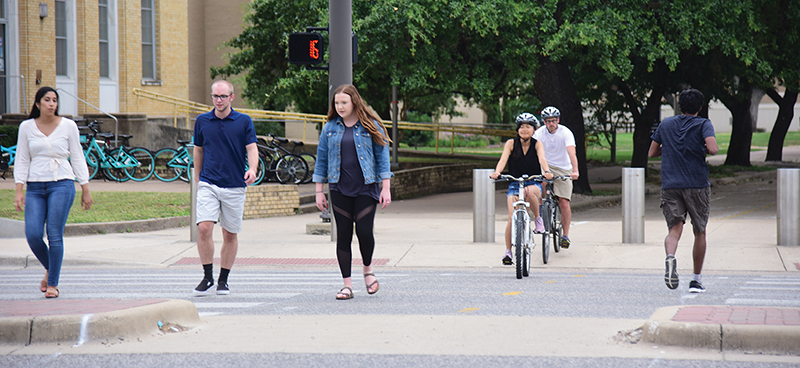
“The Campus Transformational Mobility Plan being conducted by TTI focuses on enhancing pedestrian, bicycle, transit and car-sharing options through the use of innovative technologies, services and approaches,” notes Texas A&M University Architect Lilia Gonzales. “The process involves on-campus groups, as well as local stakeholders including the Cities of Bryan and College Station, Brazos County, the BCS [Bryan/College Station] Metropolitan Planning Organization, the Texas Department of Transportation, and other public and private organizations.”

A companion project, the Campus Transportation Technology Initiative, provides companies opportunities to pilot new technologies, products and services on campus. “Both projects are fostering a more connected, walkable, bikeable and greener campus through innovative technologies and multimodal services,” says Peter Lange, associate vice president of Texas A&M University Transportation Services. “These projects are also leveraging faculty expertise and enriching student educational opportunities to work on cutting-edge research projects and experience new technology in their daily lives.”
The lessons learned at Texas A&M can help communities large and small — whether they host a college or not — improve mobility and accessibility to services while also promoting safety and security. Some of the initiatives revolutionizing Aggieland transportation are highlighted here.
-
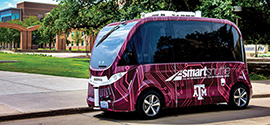 Self-driving shuttle. TTI and Texas A&M are currently testing a NAVYA self-driving shuttle operating on campus streets that include pedestrian and bicycling traffic. Researchers are assessing operational feasibility and gaining feedback from students, faculty and staff.
Self-driving shuttle. TTI and Texas A&M are currently testing a NAVYA self-driving shuttle operating on campus streets that include pedestrian and bicycling traffic. Researchers are assessing operational feasibility and gaining feedback from students, faculty and staff. -
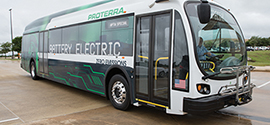 Electric buses. The Brazos Transit District and Texas A&M Transportation Services recently received a $14 million BUILD grant from the U.S. Department of Transportation with TTI’s help. The grant funds replacement of more than 30 buses with cleaner-burning, diesel alternatives. The grant also funds three battery-electric buses, which will be used on different on- and off-campus routes.
Electric buses. The Brazos Transit District and Texas A&M Transportation Services recently received a $14 million BUILD grant from the U.S. Department of Transportation with TTI’s help. The grant funds replacement of more than 30 buses with cleaner-burning, diesel alternatives. The grant also funds three battery-electric buses, which will be used on different on- and off-campus routes. -
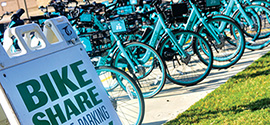 Dockless bikeshare. Texas A&M is partnering with VeoRide to offer students a pay-as-you-go bike rental option aimed at encouraging active travel across campus. TTI is analyzing the generated trip data and has developed a web-based dashboard that provides origin-destination and route information to help optimize bike routes.
Dockless bikeshare. Texas A&M is partnering with VeoRide to offer students a pay-as-you-go bike rental option aimed at encouraging active travel across campus. TTI is analyzing the generated trip data and has developed a web-based dashboard that provides origin-destination and route information to help optimize bike routes. -
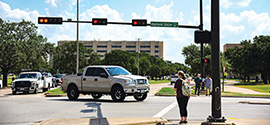 Intersection optimization. TTI is helping the university and the local communities analyze data gleaned from intersections in and around campus. Iteris® traffic signals count vehicles, bicycles and pedestrians as they move through the intersections. Using those data, traffic planners can determine usage and estimate trends to optimize intersection throughput today and plan safer, sustainable mobility solutions for tomorrow.
Intersection optimization. TTI is helping the university and the local communities analyze data gleaned from intersections in and around campus. Iteris® traffic signals count vehicles, bicycles and pedestrians as they move through the intersections. Using those data, traffic planners can determine usage and estimate trends to optimize intersection throughput today and plan safer, sustainable mobility solutions for tomorrow. -
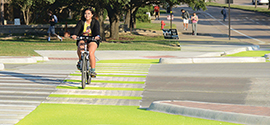 Solar energy pavement surface lighting. In 2016, TTI teamed with Texas A&M Transportation Services to install a first-of-its-kind non-signalized Dutch-style intersection on campus. The broad, bright-green pavement marking stores solar energy and keeps pathways lit at night, promoting safety for cyclists and pedestrians.
Solar energy pavement surface lighting. In 2016, TTI teamed with Texas A&M Transportation Services to install a first-of-its-kind non-signalized Dutch-style intersection on campus. The broad, bright-green pavement marking stores solar energy and keeps pathways lit at night, promoting safety for cyclists and pedestrians. -
 Destination Aggieland smartphone app. TTI led development of the award-winning Destination Aggieland mobile app in 2014. The app, which initially focused on football game days, now helps hundreds of thousands of visitors each year preplan travel routes, find parking, navigate crowded thoroughfares, and experience smoother arrivals and departures while spending less time in bumper-to-bumper traffic.
Destination Aggieland smartphone app. TTI led development of the award-winning Destination Aggieland mobile app in 2014. The app, which initially focused on football game days, now helps hundreds of thousands of visitors each year preplan travel routes, find parking, navigate crowded thoroughfares, and experience smoother arrivals and departures while spending less time in bumper-to-bumper traffic.
“The Texas A&M campus provides a living laboratory for faculty, students, researchers, staff and local community members to work together to address key transportation challenges,” says TTI Executive Associate Director Katie Turnbull, who’s leading the Campus Transformational Mobility Plan. “Harnessing the intellectual capacity, creativity and enthusiasm of all groups makes the transportation system better for all of us.”
